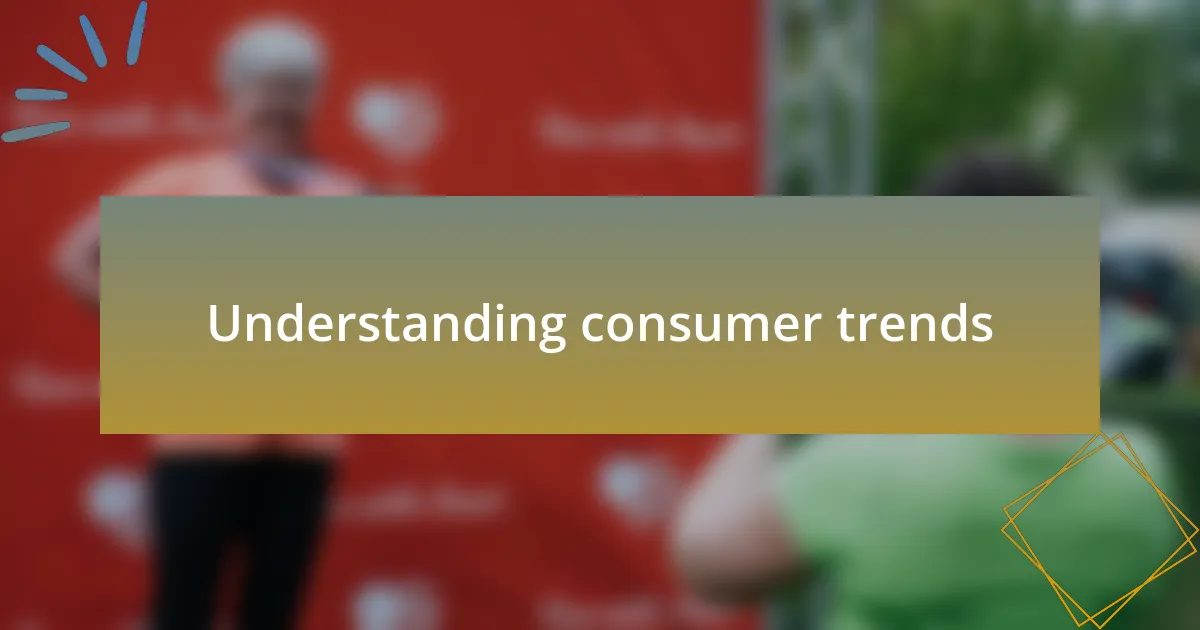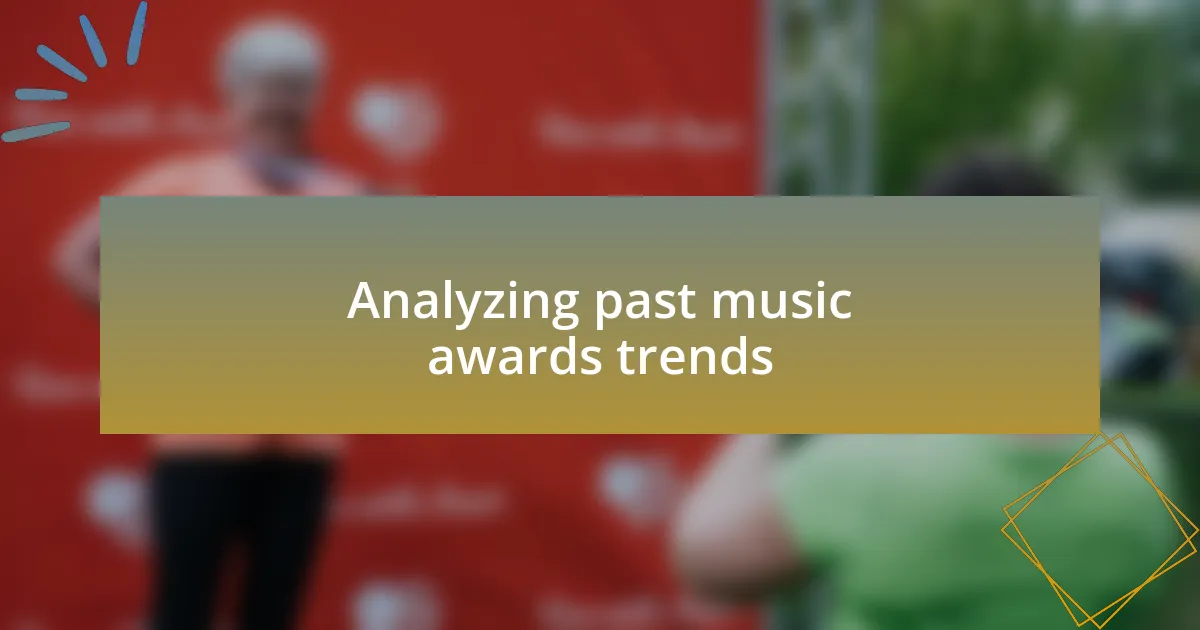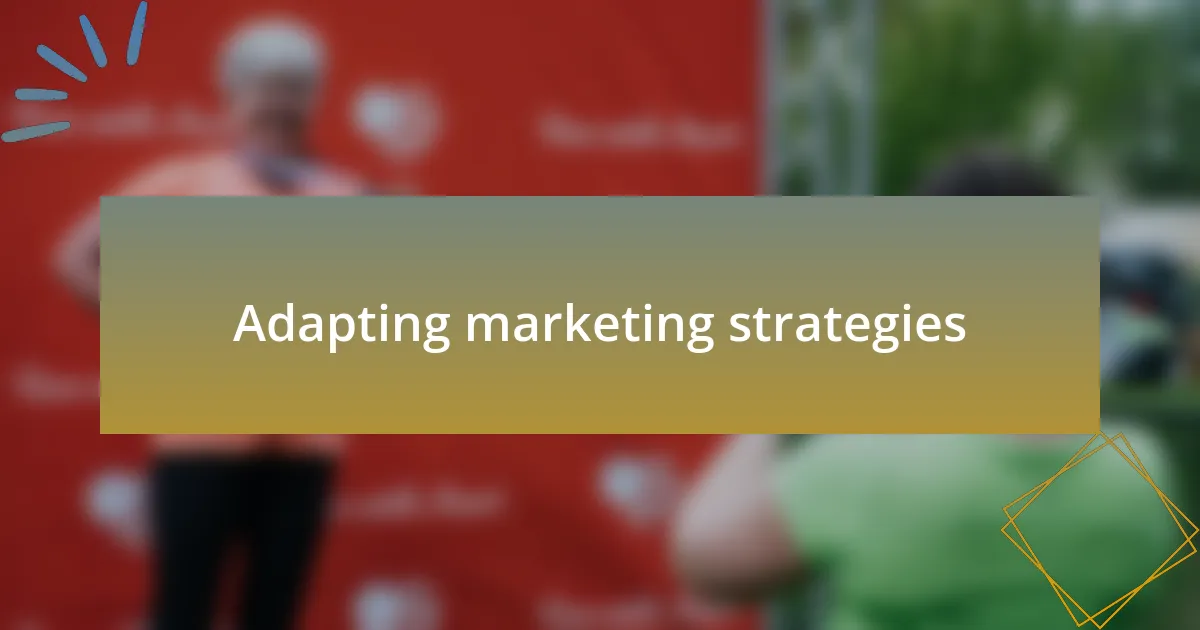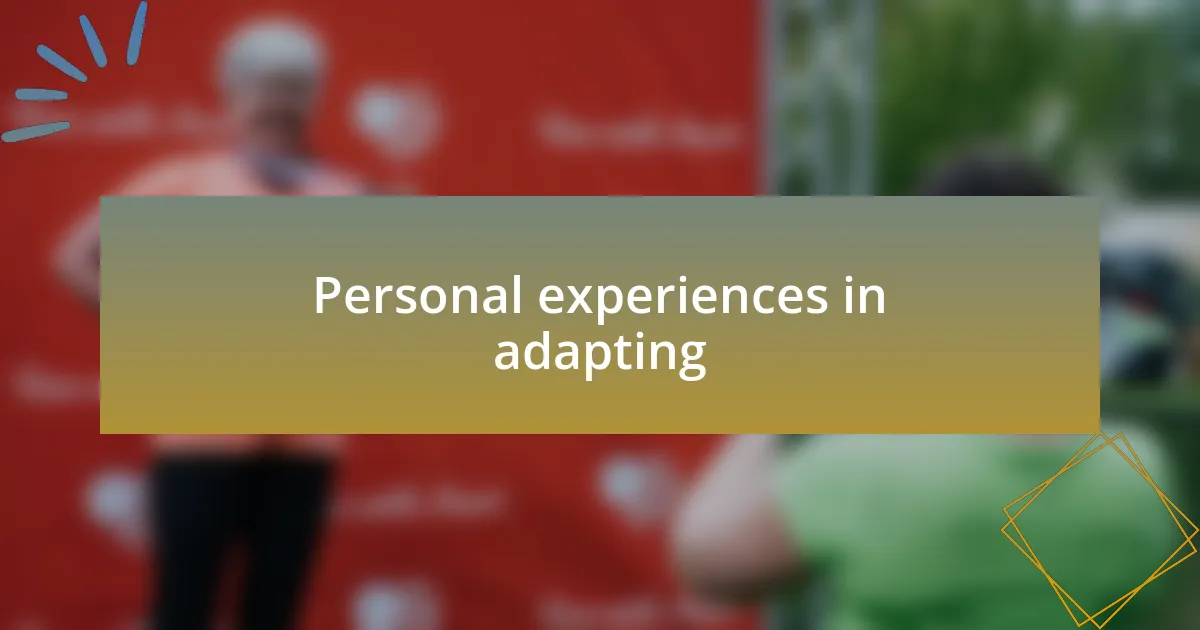Key takeaways:
- Understanding consumer trends in music awards requires empathy and adaptability, as shifts in preferences are rapidly influenced by social media.
- Past music awards have seen significant changes, including a stronger focus on diversity and inclusion, and an interplay between performance and authenticity.
- Effective marketing strategies now leverage real-time data and immersive experiences to connect with audiences, reflecting their engagement and preferences.
- Transparency and audience involvement in decision-making enhance loyalty and trust, showing the importance of storytelling and genuine connections in the awards experience.

Understanding consumer trends
Understanding consumer trends is essential for any business, especially in the dynamic world of music awards. From my experience, recognizing shifts in consumer preferences can feel almost like tuning into a new melody; it requires sharp listening and a willingness to adapt. Have you noticed how fan engagement changes with every award season? It’s fascinating.
In my career, I’ve observed that social media plays a pivotal role in shaping consumer behavior. For instance, when a new artist emerges, their popularity often surges through viral moments on platforms like TikTok. I remember when certain songs became hits overnight, and it struck me how quickly tastes could shift based on a single, captivating performance shared online. How can we, as listeners and marketers, keep pace with these rapid transformations?
Ultimately, understanding consumer trends involves more than just analyzing data—it’s also about empathy. When I reflect on my own preferences as a music fan, I realize that connection drives my choices. When artists share their stories, it resonates with me deeply. As we navigate these trends, we must ask ourselves: how do we foster that emotional connection with our audience? Each interaction can teach us more about what consumers truly desire.

Analyzing past music awards trends
Analyzing past music awards trends reveals significant shifts in how artists and audiences interact. For instance, when I think back to the early 2000s, artist performances were often center stage, while acceptance speeches took a more reserved backseat. Remember the dramatic moments, like Kanye West interrupting Taylor Swift? That moment changed how we experienced music awards, shifting focus to the interplay between performance theatrics and authenticity. It makes me wonder, do we still remember the music as vividly, or are we overshadowed by the spectacle?
As I dive deeper into the evolution, the rise of diversity and inclusion is particularly striking. I recall the year a record number of women took home awards—an exciting shift that spoke volumes about changing industry dynamics. This was a defining moment for me, as it not only highlighted emerging talent but also prompted fierce discussions among fans about representation in music. Isn’t it inspiring how these awards can drive conversations that extend far beyond the stage?
Looking at the trends, it’s evident that technology has transformed the awards landscape. Streaming platforms have created a new kind of buzz around nominees, elevating fan votes to a crucial factor. I often think about how my own voting habits have changed during award seasons, driven by playlists I curate and artists I follow closely online. How do these shifts in access and interaction reshape our expectations from award shows today? Each evolution invites us to recalibrate our understanding of success in the music industry.

Adapting marketing strategies
Adapting marketing strategies requires a keen understanding of audience engagement. I remember when social media began influencing music awards; suddenly, fan interactions were fueled by real-time reactions and online debates. It struck me how a single tweet could sway opinions and create buzz around an artist’s nomination, making it essential for marketers to craft compelling narratives that resonate with fans rather than just relying on traditional advertising.
One key adjustment has been harnessing data analytics to track consumer preferences. I’ve often found myself analyzing trends from social media platforms—what’s trending, what’s being discussed in real-time. This data offers a treasure trove of insights that help tailor promotional campaigns, ensuring they align with the current mood of the audience. Isn’t it fascinating that what once seemed like mere entertainment can now be a strategic opportunity for brands and artists alike?
Additionally, creating immersive experiences has become a vital part of marketing adaptation. I recall attending a music awards show that integrated augmented reality, allowing fans to navigate the event from their devices. It made me realize that when marketers innovate by blending technology with the live experience, they not only enhance viewer enjoyment but also foster deeper connections with the audience. How can we continue to evolve these strategies to keep pace with ever-changing consumer expectations?
Engaging with the audience’s expectations
Engaging with the audience’s expectations goes beyond mere observation; it requires active listening. I vividly remember a situation when we introduced audience polls during live award shows. The excitement that swept through the crowd as viewers saw their choices reflected on-screen was electric. It reinforced my belief that when you involve fans in decision-making, they feel valued and invested, which in turn boosts their loyalty.
I’ve also observed the power of storytelling in connecting with audiences. At one awards ceremony, a heartfelt backstory about an artist’s journey was shared, and it transformed my perception of the night. It made me realize that while nominations and wins are exciting, it’s the personal stories behind the talent that resonate with viewers, making them feel like they are part of something bigger. Isn’t it fascinating how a well-timed narrative can elevate a performance to unforgettable heights?
Furthermore, I have experienced firsthand how transparency builds trust. When award shows openly address voting processes and criteria, audiences seem to respond positively. I recall a moment when the mechanics of a fan vote were explained in detail during an event. Seeing the audience react with understanding and appreciation solidified my view that honesty cultivates a loyal fan base, as people appreciate knowing their voices truly matter in shaping outcomes. Wouldn’t it be amazing to see more brands embracing this openness?

Personal experiences in adapting
Adapting to shifting consumer trends has become a vital part of my experience. I remember a time when social media was gaining traction, and we decided to leverage platforms like Instagram and TikTok to promote the awards. The overwhelming response from younger audiences was eye-opening; it was as if a new world of interaction had opened up. Engaging directly with fans through these platforms made me realize that we could shape our brand image in a way that resonates more meaningfully with the audience’s evolving preferences.
There was another instance when we realized that diversity in nominations was paramount. After hearing feedback from fans about wanting representation across genres, we expanded our nomination categories. Seeing the joy on the faces of artists from underrepresented backgrounds was incredibly rewarding. It underscored a profound truth: when we adapt to consumer feedback, we not only enhance their experience but enrich the entire industry.
One memorable challenge I faced involved a sudden shift in music consumption trends—streaming was overtaking traditional sales. Initially, it was daunting to think about how we could maintain relevance in a changing landscape. But I quickly embraced this challenge by collaborating with artists to create exclusive streaming events. The collective enthusiasm and engagement from both artists and fans taught me that transformation can lead to exciting new opportunities. Have you ever faced a similar challenge and found a way to turn it into a success? I surely have, and I can say that the journey can be as rewarding as the outcome.